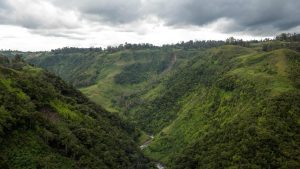
by Greg Clough
Hans Christian Andersen’s fairy tale “The Ugly Duckling” tells us that true beauty is more than skin deep. Mangrove forests tell a similar story.
Few would disagree that the weather is hotter. But the truth is, it’s always been too hot. Even before we heard the words “global warming”, summers seared. In those pioneering surfing days of the ’60s and ’70s, for some, summer was more curse than surf.
I grew up in Crib Point, Western Port Bay, Australia. A tiny town of 300 people. It froze in winter and fried in summer. In those pre-air conditioned days, waves of outback heat rolled in from the deserts, baking the house like Sunday’s roast chicken. Waves no surfer could ride, scorching our cinder block walls. Turning cottage to cauldron. The hovering heat is impossible to escape.
Sure, Crib Point is nestled on the cooling shores of Westernport Bay. And a refreshing swim was only a short bike ride away. But it wasn’t worth the pedal.
As for sandy beaches and cool dips, all Crib Point could offer were horrid mangrove swamps. I hated them. Smelly, stinky, muddy infestations made to taunt hot and sweaty kids like me. Their twisted trunks and witch-finger roots were from a horror movie—a grim swim.
Nope. For a kid, nothing good could come from a mangrove. It’s better to blast them all. Bulldoze the lot, truck in the white sand, plant some grass, build a loo, a public barbecue and, naturally, ‘put up a parking lot’.
Well, have a guess? That’s what happened. Not everywhere. But it’s far enough to make getting cool on a hot day much easier.
It would be another 20 or 30 years before I changed my mind about mangroves. By then, my wisdom was more worldly. Mangroves were more grin than grim. A boutique item among important ecosystems. A climate change combatant. Mangroves are marvellous for many reasons. Here are just a few.
- Protect coastal communities from storms: Mangroves reduce the impact of storm surges and protect coastal communities from flooding and erosion.
- Provide habitat for wildlife: They support a diverse range of flora and fauna, including migratory birds, fish, and crustaceans.
- Support fisheries: Many fish and shellfish species depend on mangrove forests, making them important for local fisheries.
- Sequester carbon: They mitigate climate change by storing large amounts of carbon in their soils and biomass.
- Filter water: Mangroves help to filter and purify water, reducing the impact of pollutants on coastal ecosystems.
- Support well-being: Mangroves contain honey, medicinal plants, shellfish, and other products locals use for their welfare and livelihoods, especially in developing countries.
Banner photo: Mangrove forest in the morning on Maira river in Iriomote island, Okinawa, Japan (Khun Ta/shutterstock.com)













